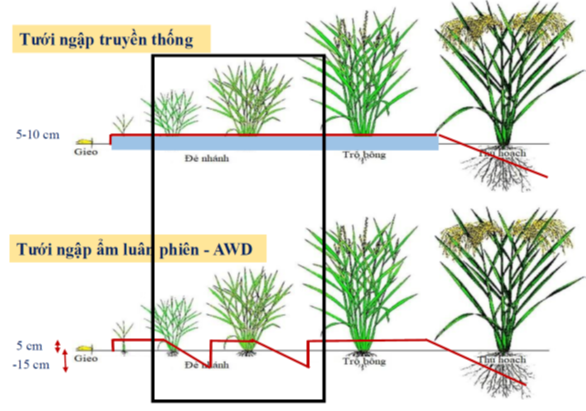Alternate Wetting and Drying (AWD) technology is shaping a new direction in climate-resilient agricultural production. When widely applied in rice cultivation, this technology plays a crucial role in efficient water resource management and significantly reduces methane emissions from rice fields. The formation of alternating dry and wet soil layers creates aerobic conditions, disrupting the habitat of anaerobic microorganisms and thereby reducing the rate of organic matter decomposition that produces greenhouse gases.
This process is maintained through precise farming techniques, involving rigorous monitoring procedures, from water level control to irrigation timing. The outcome is reduced emissions and the creation of a measurable product that can be translated into economic benefits through carbon credits. These credits become a tool to encourage farmers to maintain and replicate this model, while also connecting agricultural production to sustainable markets with climate commitments.
REDUCING EMISSIONS IN RICE CULTIVATION WITH AWD TECHNOLOGY
As traditional rice cultivation is a major source of methane emissions in rural areas, simple yet effective technical changes such as AWD have the potential to generate a significant number of credit units for companies, organizations, and nations seeking to offset their emissions. This mechanism creates a dual benefit, helping farmers secure a stable income while supporting national emission reduction targets.
With a well-established monitoring system in place, the reduced methane emissions can be recorded and uploaded to voluntary credit platforms.
The success of the AWD model in rice production heavily relies on farmers’ ability to adapt flexibly to new cultivation methods. Rural communities need access to comprehensive technical information, training on water regulation according to the rice growth cycle, and guidance on measurement and water level monitoring. Adopting water level sensor technology, online data systems, or early warning models can also enhance operational efficiency in practical production.

With swift and timely information sharing, farmers can adjust their irrigation methods according to weather conditions and the growth stage of the rice, ensuring both resource conservation and sustained productivity. Consequently, the production process meets the quality requirements for rice while generating certified carbon units eligible for the international credit market.
Unlike sectors such as energy or industry, the potential for emission reductions in agriculture is often underestimated due to measurement challenges and the lack of effective verification systems.
However, AWD technology overcomes these barriers. The stability of the irrigation model, the control over input and output factors, along with agricultural digital advancements, have paved the way for transparent measurement processes. Blockchain technology, satellite systems, and artificial intelligence are gradually being integrated into agricultural monitoring, supporting the verification of climate indicators at the field level.
By merging traditional agricultural science with modern technology, fragmented activities can be transformed into a quantifiable production system, thus qualifying for participation in the global carbon finance ecosystem.
For farmers, the most significant benefit of engaging in the carbon credit program through AWD is the potential to improve their livelihoods right on their own fields. In addition to the extra income from carbon credits, farmers can reduce water pumping costs, optimize fertilizer usage, and more effectively control pests and diseases, thereby lessening the financial burden for each crop season.
Moreover, the ability to connect with markets for high-quality and environmentally friendly rice increases, expanding the potential for agricultural trade. Financial institutions, agricultural support funds, and processing enterprises can act as intermediaries, bridging rice growers and organizations seeking carbon offsets, thus propelling the agricultural value chain toward sustainability and climate resilience.
The potential for generating carbon credits through the application of AWD technology is evident from the field results in Nghe An during the summer-autumn crop of 2024.
Actual calculations show a reduction of 71,088.3 tons of CO2e emissions over an area of 11,152.5 hectares, reflecting the superior performance of AWD technology compared to the results of the same spring crop season. The large application area and high emission reduction potential present a clear opportunity to develop the carbon credit market. This lays the foundation for establishing a green financial mechanism to attract investments in the agricultural sector.
The rice cultivation model in the study includes both traditional sowing and transplanting methods. The sowing area covered 9,277.9 hectares, achieving a reduction of 6.3 tons of CO2e per hectare, totaling 58,487.0 tons. Although the transplanting method accounted for a smaller area of 1,874.6 hectares, it achieved a higher reduction of 6.7 tons of CO2e per hectare, totaling 12,601.3 tons.
Both methods demonstrated significant potential for greenhouse gas mitigation. Each hectare of cultivation converted to AWD technology represents a step forward in reducing agricultural emissions.
ALIGNING WITH THE STRATEGY FOR CLIMATE-RESILIENT AGRICULTURAL DEVELOPMENT
The natural conditions in Nghe An are well-suited to the technical requirements of AWD technology. The climate and water resources in the region favor maintaining the AWD irrigation cycle. The province’s irrigation system has received relatively synchronized investments, ensuring flexible water supply and drainage capabilities to meet the developmental stages of rice cultivation. This is a crucial factor in the model’s practical effectiveness and potential for large-scale implementation.
Notably, the flat terrain in major rice-growing districts such as Yen Thanh, Dien Chau, and Hung Nguyen facilitates the application of a rational irrigation regime. Controlling the water level in the fields becomes feasible and more accessible, thereby enhancing water regulation efficiency, reducing waste, and improving nutrient absorption by the crop. The stability of the cultivated land also helps mitigate the risks of erosion or leakage in the irrigation and drainage canal system.
With the potential to expand the climate-friendly cultivation area, localities like Nghe An can establish a system to verify emission reductions from AWD models, gradually establishing a carbon credit trading platform for agriculture. Technical and financial support from international organizations, green agricultural development programs, and climate funds are essential for this endeavor.
In the communes participating in this model, farmers have received training and guidance on AWD irrigation techniques. Local farmers are taught how to determine the appropriate irrigation timing based on observing soil cracks in the field or using water level measurement devices.
The awareness of farmers regarding the economic and environmental benefits of this method is steadily improving. Many households report a 30-40% reduction in water usage while maintaining stable yields, encouraging them to continue adopting this practice in subsequent crop seasons.
A comparison between AWD and traditional flood irrigation reveals significant differences. Even under unfavorable weather conditions, the AWD method maintains stability in the growth and development of rice plants. The incidence of lodging due to excess water is minimized. Methane emissions are significantly reduced due to the intermittent dry periods, which disrupt the anaerobic processes that produce greenhouse gases in the soil. Thus, environmental benefits are accompanied by yield advantages.
Data from the model indicates a reduction of CO2e emissions by over 50% compared to the traditional method. Specifically, the reduction rate for sown rice is 60.11%, while for transplanted rice, it is 52.94%. This forms an essential basis for calculating carbon credits, integrating them into domestic and international carbon finance mechanisms. Each ton of reduced CO2e emissions corresponds to one carbon credit, which can be transferred, traded, or accumulated as a financial tool for reinvestment.
The effectiveness of the model in Nghe An demonstrates the feasibility of expanding AWD technology to other provinces in the deltas or midlands with similar irrigation systems. The benefits lie not only in emission reductions but also in reduced production costs, resource conservation, and environmental protection.
This approach aligns with the strategy for climate-resilient agricultural development, contributing to Vietnam’s progress toward its carbon neutrality goal.
Based on the existing research findings, it can be asserted that the AWD model in Nghe An is a crucial stepping stone toward establishing a carbon credit policy in agriculture.
Developing a Measurement, Reporting, and Verification (MRV) system is essential to ensure transparency and accuracy in credit trading activities. The scientific and practical foundation of this study can serve as a platform for developing replication plans within national target programs on climate change response.
(*) Associate Professor Dr. Nguyen Dinh Tho, Institute of Strategy and Policy on Agriculture and Rural Development;
What is the Significance of MRV in the Journey Towards Carbon Credits?
In the quest for carbon credits, the MRV (Monitoring, Reporting, and Verification) process plays a pivotal role. It is not merely a technical procedure but a crucial refining step that determines whether a project receives carbon credit accreditation.
Why Are Many Businesses Buying Carbon Credits Instead of Reducing Emissions Themselves?
In the midst of a growing global push for Net Zero commitments, the carbon credit market is experiencing a surge in demand from businesses. A prevalent trend sees companies opting to purchase carbon credits as an alternative or supplementary solution, rather than solely focusing on direct emission reductions in their production operations. This development raises questions about the motivations behind these decisions and the potential implications for the trajectory towards achieving net-zero emissions by 2050.
The End of the Road for Gas Guzzlers: A Line-Up of Fuel-Powered Cars Faces the Axe
The automotive industry is facing a significant shift with the implementation of upcoming fuel consumption limits. Manufacturers and dealers must adapt to these changing standards or risk having their vehicle models taken off the market. This development will undoubtedly impact a wide range of car and motorcycle designs, urging a necessary evolution in the industry.





















